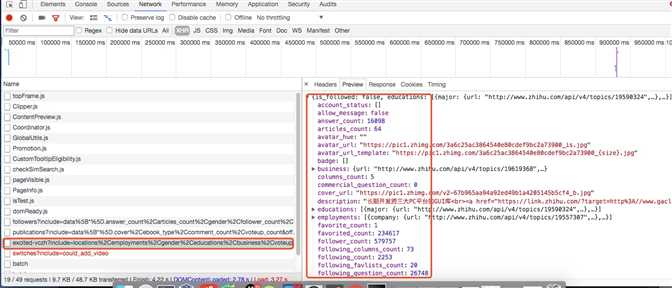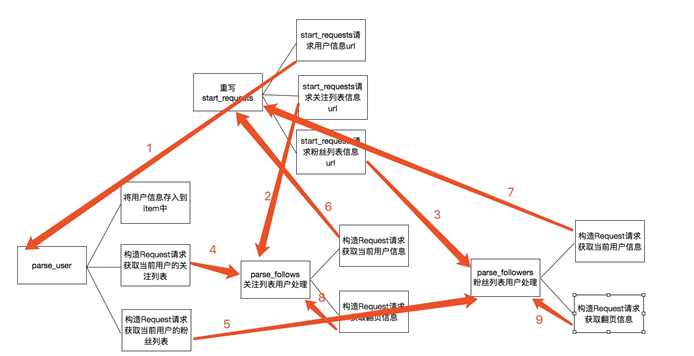标签:request org pipeline 操作 mat 表示 date mem sel
在上一篇文章中主要写了关于爬虫过程的分析,下面是代码的实现,完整代码在:
https://github.com/pythonsite/spider
class UserItem(scrapy.Item): id = Field() name = Field() account_status = Field() allow_message= Field() answer_count = Field() articles_count = Field() avatar_hue = Field() avatar_url = Field() avatar_url_template = Field() badge = Field() business = Field() employments = Field() columns_count = Field() commercial_question_count = Field() cover_url = Field() description = Field() educations = Field() favorite_count = Field() favorited_count = Field() follower_count = Field() following_columns_count = Field() following_favlists_count = Field() following_question_count = Field() following_topic_count = Field() gender = Field() headline = Field() hosted_live_count = Field() is_active = Field() is_bind_sina = Field() is_blocked = Field() is_advertiser = Field() is_blocking = Field() is_followed = Field() is_following = Field() is_force_renamed = Field() is_privacy_protected = Field() locations = Field() is_org = Field() type = Field() url = Field() url_token = Field() user_type = Field() logs_count = Field() marked_answers_count = Field() marked_answers_text = Field() message_thread_token = Field() mutual_followees_count = Field() participated_live_count = Field() pins_count = Field() question_count = Field() show_sina_weibo = Field() thank_from_count = Field() thank_to_count = Field() thanked_count = Field() type = Field() vote_from_count = Field() vote_to_count = Field() voteup_count = Field()
这些字段的是在用户详细信息里找到的,如下图所示,这里一共有58个字段,可以详细研究每个字段代表的意思:

这段代码是非常重要的,主要的处理逻辑其实都是在这里
class ZhihuSpider(scrapy.Spider): name = "zhihu" allowed_domains = ["www.zhihu.com"] start_urls = [‘http://www.zhihu.com/‘] #这里定义一个start_user存储我们找的大V账号 start_user = "excited-vczh" #这里把查询的参数单独存储为user_query,user_url存储的为查询用户信息的url地址 user_url = "https://www.zhihu.com/api/v4/members/{user}?include={include}" user_query = "locations,employments,gender,educations,business,voteup_count,thanked_Count,follower_count,following_count,cover_url,following_topic_count,following_question_count,following_favlists_count,following_columns_count,avatar_hue,answer_count,articles_count,pins_count,question_count,columns_count,commercial_question_count,favorite_count,favorited_count,logs_count,marked_answers_count,marked_answers_text,message_thread_token,account_status,is_active,is_bind_phone,is_force_renamed,is_bind_sina,is_privacy_protected,sina_weibo_url,sina_weibo_name,show_sina_weibo,is_blocking,is_blocked,is_following,is_followed,mutual_followees_count,vote_to_count,vote_from_count,thank_to_count,thank_from_count,thanked_count,description,hosted_live_count,participated_live_count,allow_message,industry_category,org_name,org_homepage,badge[?(type=best_answerer)].topics" #follows_url存储的为关注列表的url地址,fllows_query存储的为查询参数。这里涉及到offset和limit是关于翻页的参数,0,20表示第一页 follows_url = "https://www.zhihu.com/api/v4/members/{user}/followees?include={include}&offset={offset}&limit={limit}" follows_query = "data%5B*%5D.answer_count%2Carticles_count%2Cgender%2Cfollower_count%2Cis_followed%2Cis_following%2Cbadge%5B%3F(type%3Dbest_answerer)%5D.topics" #followers_url是获取粉丝列表信息的url地址,followers_query存储的为查询参数。 followers_url = "https://www.zhihu.com/api/v4/members/{user}/followers?include={include}&offset={offset}&limit={limit}" followers_query = "data%5B*%5D.answer_count%2Carticles_count%2Cgender%2Cfollower_count%2Cis_followed%2Cis_following%2Cbadge%5B%3F(type%3Dbest_answerer)%5D.topics" def start_requests(self): ‘‘‘ 这里重写了start_requests方法,分别请求了用户查询的url和关注列表的查询以及粉丝列表信息查询 :return: ‘‘‘ yield Request(self.user_url.format(user=self.start_user,include=self.user_query),callback=self.parse_user) yield Request(self.follows_url.format(user=self.start_user,include=self.follows_query,offset=0,limit=20),callback=self.parse_follows) yield Request(self.followers_url.format(user=self.start_user,include=self.followers_query,offset=0,limit=20),callback=self.parse_followers) def parse_user(self, response): ‘‘‘ 因为返回的是json格式的数据,所以这里直接通过json.loads获取结果 :param response: :return: ‘‘‘ result = json.loads(response.text) item = UserItem() #这里循环判断获取的字段是否在自己定义的字段中,然后进行赋值 for field in item.fields: if field in result.keys(): item[field] = result.get(field) #这里在返回item的同时返回Request请求,继续递归拿关注用户信息的用户获取他们的关注列表 yield item yield Request(self.follows_url.format(user = result.get("url_token"),include=self.follows_query,offset=0,limit=20),callback=self.parse_follows) yield Request(self.followers_url.format(user = result.get("url_token"),include=self.followers_query,offset=0,limit=20),callback=self.parse_followers) def parse_follows(self, response): ‘‘‘ 用户关注列表的解析,这里返回的也是json数据 这里有两个字段data和page,其中page是分页信息 :param response: :return: ‘‘‘ results = json.loads(response.text) if ‘data‘ in results.keys(): for result in results.get(‘data‘): yield Request(self.user_url.format(user = result.get("url_token"),include=self.user_query),callback=self.parse_user) #这里判断page是否存在并且判断page里的参数is_end判断是否为False,如果为False表示不是最后一页,否则则是最后一页 if ‘page‘ in results.keys() and results.get(‘is_end‘) == False: next_page = results.get(‘paging‘).get("next") #获取下一页的地址然后通过yield继续返回Request请求,继续请求自己再次获取下页中的信息 yield Request(next_page,self.parse_follows) def parse_followers(self, response): ‘‘‘ 这里其实和关乎列表的处理方法是一样的 用户粉丝列表的解析,这里返回的也是json数据 这里有两个字段data和page,其中page是分页信息 :param response: :return: ‘‘‘ results = json.loads(response.text) if ‘data‘ in results.keys(): for result in results.get(‘data‘): yield Request(self.user_url.format(user = result.get("url_token"),include=self.user_query),callback=self.parse_user) #这里判断page是否存在并且判断page里的参数is_end判断是否为False,如果为False表示不是最后一页,否则则是最后一页 if ‘page‘ in results.keys() and results.get(‘is_end‘) == False: next_page = results.get(‘paging‘).get("next") #获取下一页的地址然后通过yield继续返回Request请求,继续请求自己再次获取下页中的信息 yield Request(next_page,self.parse_followers)
上述的代码的主要逻辑用下图分析表示:

关于上图的一个简单描述:
1. 当重写start_requests,一会有三个yield,分别的回调函数调用了parse_user,parse_follows,parse_followers,这是第一次会分别获取我们所选取的大V的信息以及关注列表信息和粉丝列表信息
2. 而parse分别会再次回调parse_follows和parse_followers信息,分别递归获取每个用户的关注列表信息和分析列表信息
3. parse_follows获取关注列表里的每个用户的信息回调了parse_user,并进行翻页获取回调了自己parse_follows
4. parse_followers获取粉丝列表里的每个用户的信息回调了parse_user,并进行翻页获取回调了自己parse_followers
通过上面的步骤实现所有用户信息的爬取,最后是关于数据的存储
这里主要是item中的数据存储到mongodb数据库中,这里主要的一个用法是就是插入的时候进行了一个去重检测
class MongoPipeline(object): def __init__(self, mongo_uri, mongo_db): self.mongo_uri = mongo_uri self.mongo_db = mongo_db @classmethod def from_crawler(cls, crawler): return cls( mongo_uri=crawler.settings.get(‘MONGO_URI‘), mongo_db=crawler.settings.get(‘MONGO_DATABASE‘, ‘items‘) ) def open_spider(self, spider): self.client = pymongo.MongoClient(self.mongo_uri) self.db = self.client[self.mongo_db] def close_spider(self, spider): self.client.close() def process_item(self, item, spider): #这里通过mongodb进行了一个去重的操作,每次更新插入数据之前都会进行查询,判断要插入的url_token是否已经存在,如果不存在再进行数据插入,否则放弃数据 self.db[‘user‘].update({‘url_token‘:item["url_token"]},{‘$set‘:item},True) return item
Python爬虫从入门到放弃(十九)之 Scrapy爬取所有知乎用户信息(下)
标签:request org pipeline 操作 mat 表示 date mem sel
原文地址:http://www.cnblogs.com/zhaof/p/7228131.html